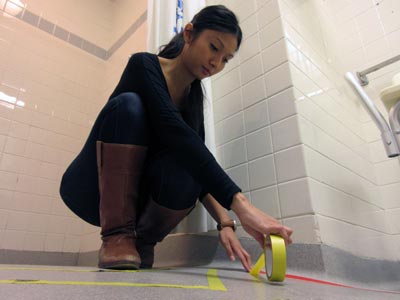
Minette Abu replaces the high visibility tape that is now being used to warn people of the slope on the shower floor. Since she first put it down, there have been no falls.
(Photo: LEAN)
Imagine if no two patients at UHN ever tripped and fell on the same loose cable or wrinkled carpet because staff identified the problem and fixed it immediately.
Staff in a high reliability organization strive to prevent accidents, but when something happens they learn from it. And that's exactly what Minette Abu, a registered nurse at Toronto Western Hospital, has done.
The patients Minette cares for on the 6A Neurovascular Unit have suffered strokes or neurological deficits. They are usually older and with some impairments, either physical, cognitive or both. Although many are at high risk of falling, an effective prevention process ensures incidents are infrequent.
During the team's daily huddle, she learned that while she was on a day off one of her patients had fallen. Surprisingly, it was a younger person with no cognitive or physical impairments.
Her curiosity piqued, Minette promised the team she would speak to the patient about what happened. Talking with patients or family after an incident is a standard part of the team's post-fall process.
"He said the shower floor had a slope that he couldn't see when he was stepping out, it was wet and the slope wasn't marked," says Minette. "When I looked at the shower from the perspective of a person using it, I could see how anyone could fall there, even me."
The shower is scheduled for renovation later in 2016, but the team decided they couldn't put more patients at risk by waiting. After Minette spoke with the patient, her colleague, Grant Price, a nurse, she marked the floor using tape to make the slope highly visible. Since then, no one has fallen.
Units across UHN are employing this type of problem solving to protect patients by preventing harm: two have achieved 30 consecutive days without a fall. In the past they would have averaged as many as four falls in the same time period.
"There is no magic solution for preventing falls," says Minette. "You have to assess, put the interventions in place, and if something still happens, you need to find out why and keep it from happening again."
